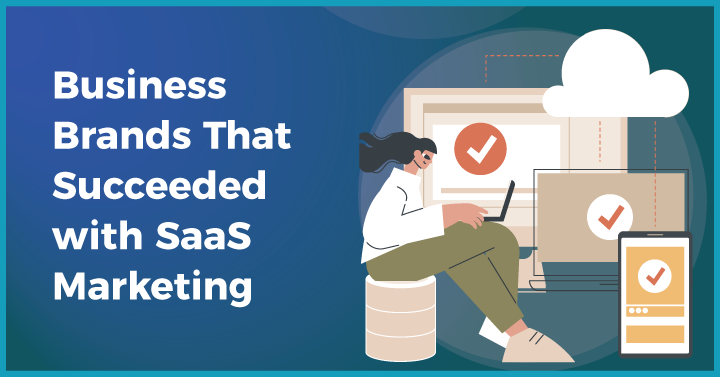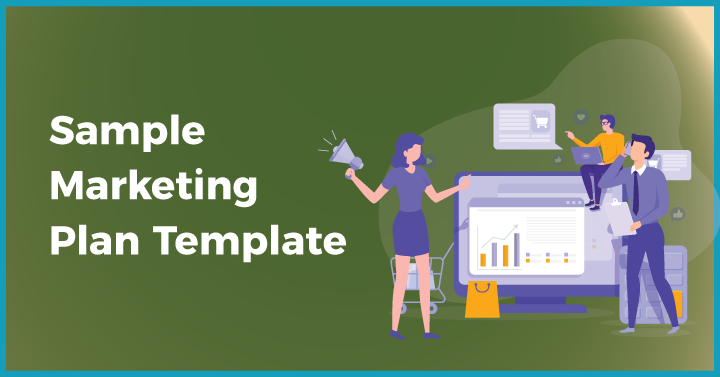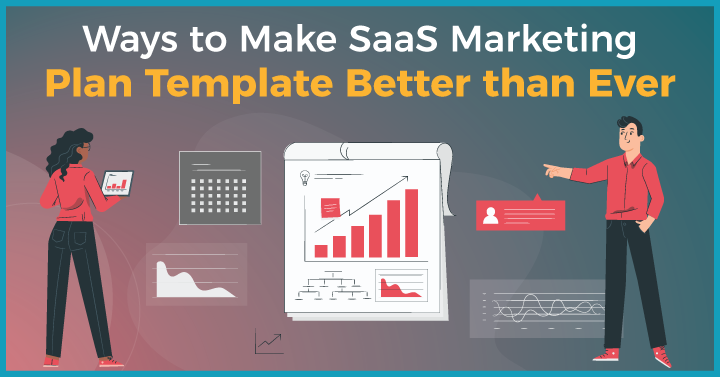Each marketing campaign you create will be unique, but that doesn’t mean you have to start from scratch every time. A SaaS marketing plan template distills the essential elements of a successful strategy, which can then be repurposed according to the goals you hope to achieve.
In this post, learn more on what a SaaS marketing plan template is and how to create one that meets the mark for your Saas business goals.
1. What Is a SaaS Marketing Plan Template?
A good B2B SaaS marketing plan template ensures you consider several key points every time you launch a marketing campaign, so that you can make it a success. Unfortunately, it’s not as easy as copying and pasting the same actions every time, but it does mean you can feel confident you are setting out on strong footing, breaking down the different elements in a logical, considered way.
2. Benefits of Marketing Plan Template for SaaS Businesses
- Saves time – The number-one benefit of having a B2B marketing plan template is that you don’t have to start from scratch, each time you create a marketing strategy.
- Systematic approach – By utilizing a pre-built framework, you can ensure you don’t miss out on any important aspects of your marketing in the planning stage.
- Review and renew – Your SaaS marketing plan template doesn’t have to be a static document, which means you can adapt it to improve efficiency and prepare for roadblocks according to past experience.
3. 10 Ways to Create an Effective SaaS Marketing Plan Template
3.1 Create a Viable Marketing Plan
No marketing campaign is provided with unlimited budget, time and resources. How you structure a SaaS marketing team will depend upon how much money you have to spend, how long you have to achieve the stated objectives and what other resources in terms of staff and software are at your disposal.
3.2 Breakdown Big Goals into Actionable Chunks
Overarching business goals can be made more manageable if broken into smaller pieces. There are many different approaches you can take to achieve this, but one method when creating your template is to consider goals according to the different customers you are addressing. These could be customer retention, lead generation, conversion rates or higher search rankings. These can be subdivided by position in the sales funnel, starting with awareness, moving through interest and evaluation, and ending with action. In addition to these, you can add two further types: those aimed at existing customers and those aimed at churned customers.
For example, in terms of awareness, your goal might be to reach at least 1m leads, while for churned customers, your goal might be to have a specific win-back rate percentage.
3.3 Formulate Strategies to Reach the Sub-Goals
Once you’ve created your sub-goals by customer category, you then need to outline strategies for achieving those objectives.
If one of your goals is to generate more impressions, you might consider using pay-per-click advertising. Alternatively, if you are hoping to decrease churn, you might look at improving educational resources on your website around how to use your product or generating greater awareness about software updates via email marketing.
3.4 Analyze and Evaluate Your Results
As with every SaaS growth plan template, your marketing template should include regular data analysis, so you can see more clearly what goals are being achieved, what strategies are working and where improvement is needed. You can compare these with competitor analysis reports based on parameters such as organic rankings, ad campaigns, or social media activity to understand audience or user behavior.
Building evaluation into your plan ensures you don’t forget to assess and adapt your campaign as you progress.
3.5 Build an SEO Strategy
Consider what kind of evergreen content will help you organically grow awareness and attract potential customers to your website. The first step is to define the keywords that will draw the right audience using a tool such as Google’s Keyword Planner. With this information in hand, you can then build product landing pages and write long-form articles to cater to search intent.
Don’t forget to include plans for a website audit of technical issues as well as a backlinking strategy in your template – both of these will also help improve the SEO of your pages.
3.6 Use Taglines to Highlight the Main Benefits
What words best encapsulate how your SaaS product can help solve a particular business case? Coming up with a few key phrases is extremely useful for creating recall in the minds of your prospects, and the snappier the better.
Don’t forget that features and benefits are not the same. The former is simply a description of functionality, while the latter explicitly explains why that functionality helps the customer.
3.7 Give In-Depth Information About Each Feature
Once you’ve nailed the taglines, you can then expand upon your SaaS solution’s use cases, defining why your target businesses absolutely must have it in their lives.
It’s a good idea here to use keyword analysis to assess what terms and phrases people search for in different instances. This helps generate organic traffic and direct people towards your website.
3.8 Add CTAs
Calls to action are absolutely crucial in any marketing plan. They ease potential customers down the sales funnel and create a pathway of action.
CTAs can appear in a variety of instances, from website landing pages to LinkedIn Sponsored InMail, so take the time to think about the wording you desire for each according to the stage of the sales cycle the customer is at.
3.9 Offer Free Trials and Demos
If you have a solid product, why not showcase the fact through a free trial or demo? Free trials have been shown to have a greater effect on conversions in B2B than B2C, as they allow businesses to feel more secure in the fact that they are getting a SaaS solution that has usability as well as functionality.
Your SaaS marketing plan template should prompt you to consider the different times and places you can offer a free demo, depending on the different touch points you have with your customers.
3.10 Drip Email Campaign to Nurture Prospects
Drip email campaigns are a great way to control the customer journey and maximize potential conversions. Most sales don’t take place the first time a prospect hears about your product. They require nurturing, often through a series of communications, in order to develop their appreciation of your product’s use cases.
Your drip email campaign might start with a welcoming email outlining the basis features of your SaaS product, followed by more details of the features and benefits, then perhaps blog posts or other value-added content that showcase you as a reputable industry player, before a final prompt to sign up for the full version. Experiment with what works for your solution with A/B testing.
4. Business/Brands That Succeeded with SaaS Marketing

4.1 Xero
Accounting SaaS Xero managed to grow into a huge player in the space of a decade by creating a comprehensive marketing plan that included email marketing, paid search, content marketing and social media engagement.
4.2 Breezy
Beezy employed SaaS marketing agency Kalungi’s ‘playbook’ marketing plan template to formulate its strategy. The digital workplace platform saw a 63% increase in organic traffic and a qualified sales pipeline worth $2m as a result.
4.3 Moosend
As mentioned above, it’s important not to forget to include analysis and evaluation as part of a marketing plan. Email marketing software Moosend found that performing a full SEO and content audit automatically led to the creation of new strategies that better targeted their audience, resulting in increased organic traffic and mentions on review sites.
5. Sample Marketing Plan Template

Marketing plans can range from being simple one-page strategies to complex documents, depending on the breadth of your operation. Here’s a simple, one-page marketing plan example that covers the basic points.
5.1 Business Summary
This is essentially the mission statement, with brief details on who you are and a general overview of what you hope to achieve.
5.2 Target Objectives
Specify exactly what measurable activities you are aiming at and the timeframe. Don’t forget to focus on the creation of actionable chunks, as described above.
5.3 Customer Segmentation
Detail the types of companies you hope to reach and the buyer personas within those companies. Having these clearly defined will make marketing to them much easier.
5.4 Budget and Resources
List out the proposed budget, including money for paid ads, content creation and any software that will be needed. You can include details of the personnel needed/involved here, or this can be set out under a separate section for added clarity.
5.5 Marketing Strategies
How exactly are you going to achieve your target objectives? This is where you will detail your use of imagery, taglines, CTAs, free demos, etc. You can also include an explanation here of how you will quantify and analyze success.
5.6 Marketing Channels
How are you reaching your customers? Specify your email marketing, social media and any other media through which you intend to reach leads, with accompanying description of why this particular channel is necessary.
6. FAQs
- How Do I Create a SaaS Marketing Plan?
The first step to creating a SaaS marketing plan template is to have your goals specified, then break those down into subgoals as necessary. Once you’ve done that, you can go about creating strategies.
- What Is a SaaS Marketing Plan vs. a Traditional Marketing Plan
One of the main differences between SaaS marketing and traditional marketing is that SaaS companies should always have retention strategies in mind when formulating a strategy. Where traditional marketing primarily focuses on lead generation and sales, SaaS marketing goes beyond initial conversions to encourage continuous renewal of subscriptions or licenses.











